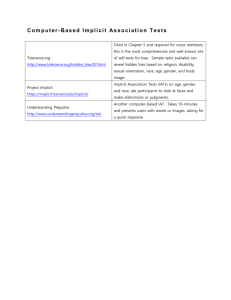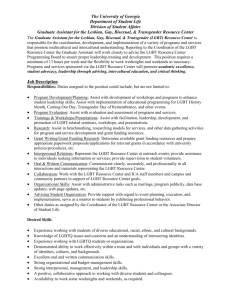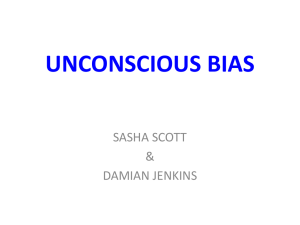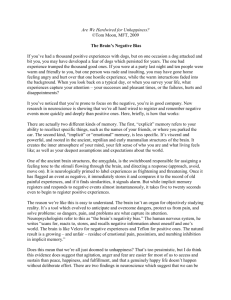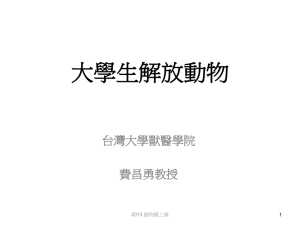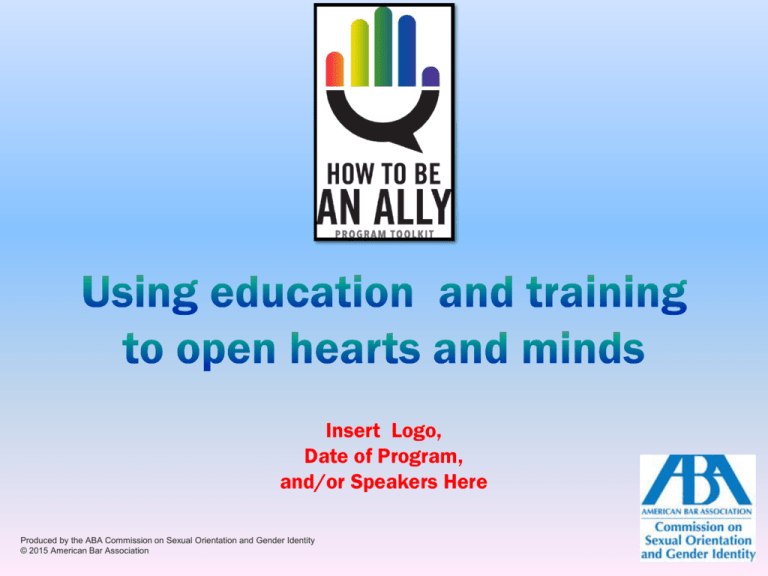
Insert Logo,
Date of Program,
and/or Speakers Here
Produced by the ABA Commission on Sexual Orientation and Gender Identity
© 2015 American Bar Association
Insert Presenter Name
• Bullets about Presenter
Agenda for Today
•
•
•
•
•
•
Presentation on Ally Training and Icebreaker
Discussion of Implicit Bias
Presentation of Scenarios
Discuss Best Practices Guide
Participant Goal Setting
Close Program
Being an LGBT Ally
First Thoughts
Ice Breaker
DISABLED
WHITES
BISEXUALS
GAYS
NEW YORKERS
WOMEN
MEN
LATINOS
TRANSGENDERED
ASIANS
POLICE OFFICERS
CALIFORNIANS
AFRICAN-AMERICANS
LESBIANS
TEACHERS
TRANSEXUALS
LGBT Terminology 101
How to define Sexual orientation, Gender identity, and Gender Expression
• "Sexual orientation“: is the preferred term used when referring to an
individual's physical and/or emotional attraction to the same and/or
opposite gender. "Heterosexual," "bisexual" and "homosexual" are all
sexual orientations.
• "Gender identity“: refers to a person's innate, deeply felt psychological
identification as male or female, which may or may not correspond to
the person's body or designated sex at birth (meaning the sex originally
designated on the person's birth certificate).
• “Gender expression”: refers to how a person outwardly expresses their
gender.
LGBT Terminology 101
•
•
•
•
How to define lesbian, gay, bisexual and transgender, and other terms
"Lesbian": a woman whose physical and/or emotional attachments are to
women.
"Gay": a man whose physical and/or emotional attachments are to men.
"Bisexual": a man or woman whose physical and/or emotional attractions
and attachments are to persons of both genders.
“Transgender": an umbrella term that includes individuals of varying
gender behaviors, inclusive of, but not limited to: ‘transsexuals’ who
experience and/or express their gender identify by identifying or referring
to themselves as having a gender other than that listed on the
individual's original birth certificate, or by physically changing their sex;
‘heterosexual cross dressers’ and ‘drag queens and kings,’ who identify
as their natal gender, but present as another gender for social, political
or economic reasons; ‘transvestites’ who cross dress for psychosexual
reasons; and others who question their gender identity or expression.
LGBT Terminology 101
LGBT Do’s & Dont’s
Assumptions / Stereotypes
Terminology and word choices
Conversation
Awareness
Transgender
Gender neutrality
Pronouns
Bathrooms
Support
LGBT Implicit Bias
Implicit Bias
unconscious stereotyping and
prejudice that impacts perceptions
of and behaviors toward social
groups
LGBT Implicit Bias
Am I biased?
Yes
Whether we are female/male,
affluent/not affluent,
black/white/Hispanic/Asian/Native
American/immigrant, gay/straight,
disabled/abled, older/younger
LGBT Implicit Bias
Example of what IAT tests
Say the Color
LGBT Implicit Bias
Say the Color
LGBT Implicit Bias
How do I measure my biases?
Take the Implicit Association Test
https://implicit.harvard.edu/implicit/takeatest.html
Race IAT
Gender IAT
Age IAT
Weight IAT
LGBT Implicit Bias
How Can I learn more
about LGBT implicit
biases?
View the SOGI LGBT
Implicit Bias Webinar
Click Here to view
LGBT Implicit Bias
Produce your own live or
teleconference
presentation on LGBT
implicit Bias
For Speaker Suggestions
visit the Toolkit Speakers
Database
Click Here to view
Working Through
Real-World Scenarios
•
•
•
•
Scenario Objectives
Facilitate a robust discussion of each scenario.
Equip participants with the tools to address each
real-world scenario from multiple viewpoints.
Present a format that is flexible enough to allow a
group to focus on a particular issue within any
given scenario.
Serve as a self-contained study kit for individuals.
Working Through
Real-World Scenarios
•
•
•
•
•
•
•
•
•
Scenario Topics
Dealing with open LGBT discrimination in the
workplace
The ‘coming out’ process
Creating a more ‘gay-friendly’ work environment
Job satisfaction
Helping LGBT
Marriage and family
Gender Stereotypes
Physical appearance
Perceived Harassment
LGBT Best Practices
in the Workplace
A Guide outlining
steps for promoting
(internally and
externally) LGBT
diversity
Download
Here
Individual
Goal Setting
• Examples could include:
– Sending an email six months
after training to ask participants
to reflect on their progress.
– Asking participants to write down
their goals and give them to
trainer/diversity partner who can
keep a copy and provide a copy to
participants and then check in
down the line.
Leveraging Your
Content
• Appoint scribes charged with
taking detailed notes of your Ally
training. Use the scribe’s notes to
create a follow-up article to be
published.
• Distribute news of the program
and follow-up report or article in
social media.
• Consider taping all or part of the
program to create podcasts and
post online.
Wrapping Up!
• Thank you for joining us today,
and please help us spread the
word!
For more information and to
download other resources for
the Toolkit, visit the ABA
Commission on Sexual
Orientation and Gender Identity
website at www.ambar.org/ally
Thank You!
The SOGI Commission would like
to thank AT&T for making this
toolkit a reality.
We would also like to thank and
recognize the hard for of the
Toolkit Committee, led by SOGI
Commission Takeia Johnson.

